More stories of wildlife at airports
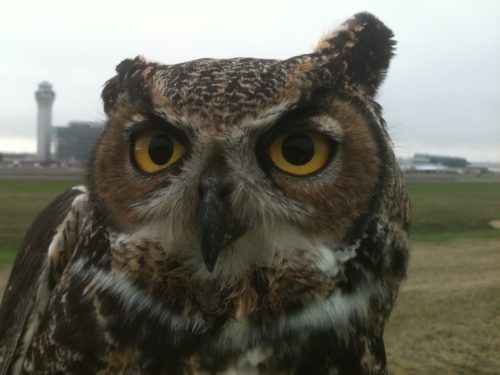
Courtesy Port of Portland
I’ve been getting more stories about wildlife ‘incidents’ at airports since my “At the Airport” column – “From worms to whales, the wildlife that worries airports,” appeared online and in print at USA TODAY and will share some of them in future posts.
In the meantime – in case you missed it, here’s a slightly edited version of that column that was inspired by the report of a large alligator caught on tape sauntering across a taxiway between two ponds at Orlando International Airport.
That’s so Florida! Pilots of a Spirit flight departing MCO today had to pause on the taxiway and give right of way to a local resident out for a morning stroll. Passengers caught a rare glimpse of an alligator trudging from one pond to the next. 🐊 pic.twitter.com/xK12ydomLX
— Orlando International Airport (@MCO) June 11, 2018
Whle the gator’s journey alarmed passengers and slightly delayed a Spirit Airlines flight on its way to the gate, at MCO airport wildlife visitors are not rare.
“For that reason,” said MCO’s Carolyn Fennell, “We have a biologist and wildlife unit on staff to help with planning new facilities, monitoring and relocating, when needed, various ‘critters’ on our property.”
All airports must manage resident and visiting wildlife because birds (mostly), as well as deer, alligators, coyote, moose and even an excess of worms on the runway after a rain (a feast for birds) can create safety hazards that lead to costly and, in some same cases, deadly collisions between aircraft and animals.
A report from the Federal Aviation Administration and the U.S. Department of Agriculture estimated that in 2015 alone wildlife strikes would ding the US civil aviation industry about $229 million in direct costs and require more than 69,000 hours of aircraft downtime. But despite lingering memories of the 2009 bird strike near New York’s LaGuardia Airport that led to the “Miracle on the Hudson,” Cody Baciuska of Loomacres Wildlife Management says “Passengers should not be concerned about experiencing a strike the next time they fly.”
His confidence comes from the fact that airports are aggressive about managing and monitoring wildlife and constantly network with each other about best practices for deploying a wide variety of tools that include everything from visual and auditory deterrents, fencing, netting and spikes to lasers and all manner of pyrotechnics
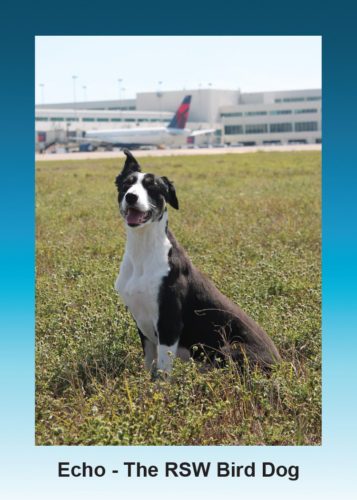
In 1999, Southwest Florida International Airport (RSW) in Fort Myers was the first airport to add a Border collie to it wildlife management team to help shoo away birds that might otherwise nest and roost on airport property. (The current dog is named Echo; previous ones were Jet, Radar, Sky and Aero.)
In 2007, Seattle-Tacoma International was the world’s first airport to install an avian radar system to monitor potentially hazardous bird activity near the airport.
Elsewhere, airports team up with airlines, environmental groups, community volunteers and others to humanely trap, relocate and resettle raptors such as hawks, ospreys and owls.
On the east coast United Airlines, Audubon International and the Port Authority of New York & New Jersey work together to trap American kestrels (a climate-threatened small falcon) at Newark Liberty International Airport and send them to new homes on area golf courses with more welcoming habitats.
Each year Seattle-Tacoma International Airport carefully collects and relocates fuzzy baby chicks from the nests of resident red-tailed hawks.
“We actually climb the trees and take the chicks out of the nest and take them up north where we raise them to imprint on a different location,” said Mikki Viehoever, the wildlife biologist for the Port of Seattle.
Portland International Airport, located on the confluence of the Columbia and Willamette Rivers and along a Pacific migratory flight path for birds, has a very active raptor translocation program.
“Trapped raptors are taken to suitable release sites in Oregon & Washington by car or plane,” said Nick Atwell, wildlife manager for the Port of Portland. “We’ve partnered with Alaska Airlines for transport to northern Washington with the intent of increasing the distance from PDX.”
Atwell and his team tag and band each bird they relocate and keep an online database of sightings. “We want to track the success or failure of the program,” said Atwell. “And find out if a bird comes back to the airport and inform other airports what might be the best distance for translocating animals.”
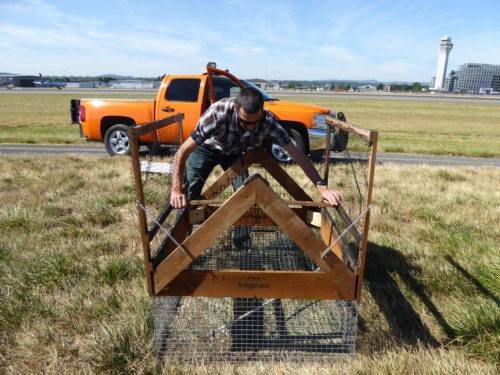
Still, wildlife happens.
Some airports keep special vacuums in their tool sheds or a beekeeper on speed-dial to remove bees that sometimes swarm on airplane wings.
In January 2017, a 15-foot dead whale washed up near the end of a runway at New York’s LaGuardia Airport. “We worked with the Army Corps of Engineers to remove it,” said Laura Francoeur, chief wildlife biologist for the Port authority of New York and New Jersey, “Because you don’t want to leave a dead whale there to attract scavengers.”
Each year during nesting season for Diamondback terrapins, Fancoeur and her team also monitor the turtles migrating between a nearby wildlife refuge and the shores of Jamaica Bay. In past years, hundreds of turtles marched – slowly – across a runway, causing planes to be delayed. Now plastic barriers keep most of the turtles out of harm’s way, while staff swoop in to gather up and relocate any terrapins that insist on taking the shortcut.
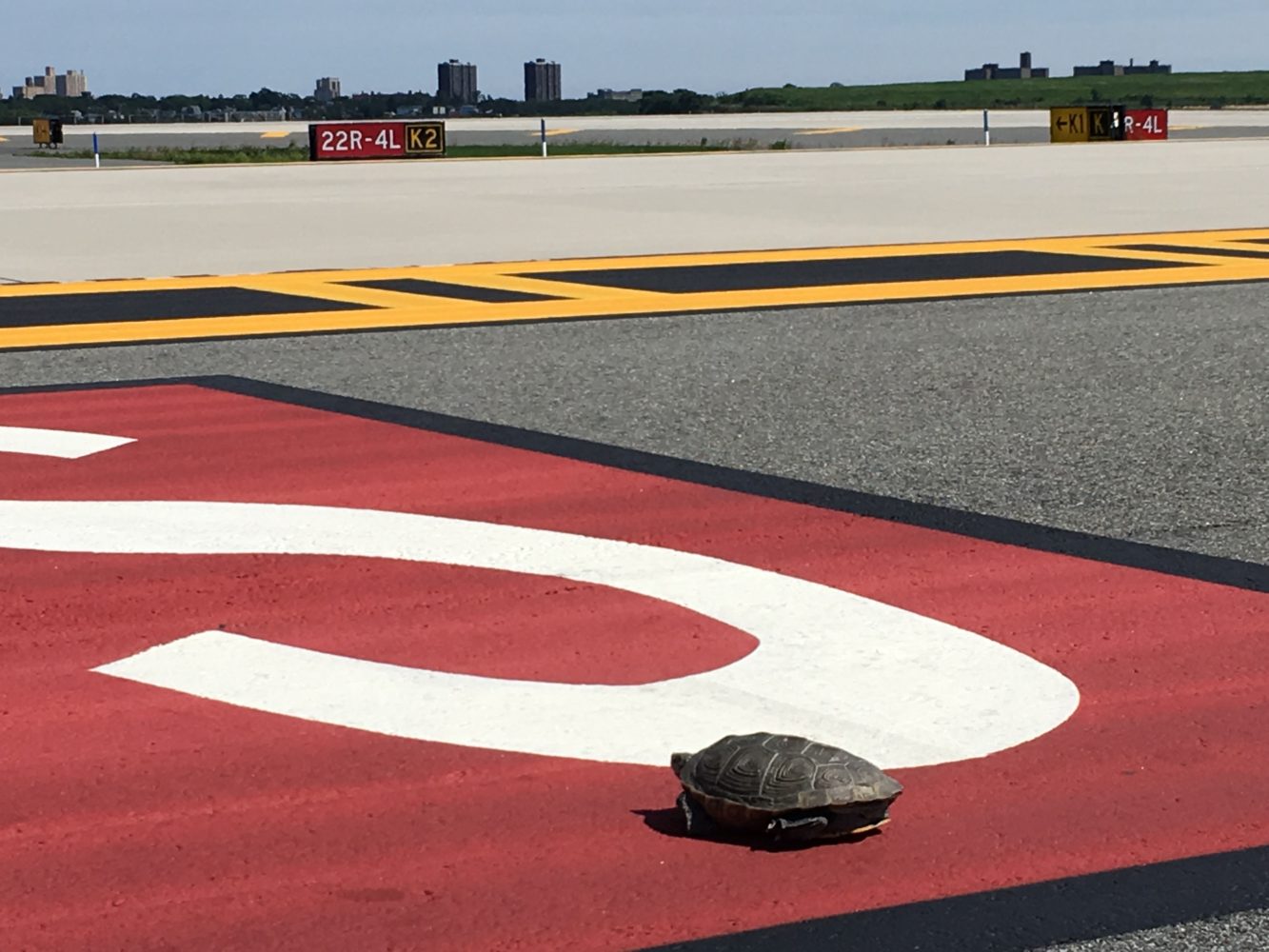
Photo_Port Authority of New York and New Jersey
In addition to capturing and relocating alligators – some more than 9 feet long – at some southern airports, wildlife biologists and wildlife technicians from the USDA’s Wildlife Services unit help keep a zoo’s worth of wildlife away from taxiways and runways. Their ‘highlight’ list includes Nile Monitor Lizards, pythons, porcupines (whose quills can damage airplane tires) and loons.
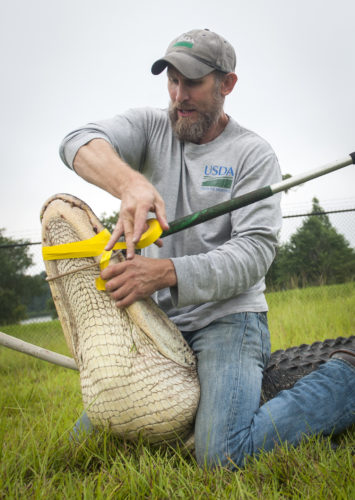
Courtesy USDA Wildlife Services
“What most people may not know about loons is that they are unable to walk on land,” said USDA spokeswoman Tanya Espinosa. Loons may land on a wet runway believing they’re landing on water and are then unable to get back up. “Our employees have had to physically pick loons up in order to release them,” said Espinosa.
At some coastal airports oysters, clams and other shellfish have become an issue, requiring teams to go out with sweepers.
“During low tides, gulls and other birds go hunting for shellfish and then drop them on open areas, such as runways, to crack them open,” said Espinosa, “While this is a great example of bird ingenuity, it is very dangerous for airports as sharp shell parts can puncture tires, get sucked into engines, damage aircraft and cause accidents.”
In Alaska, USDA Wildlife Biologists and Wildlife Technicians also help wrangle musk ox and caribou.
Musk Ox sometimes form defensive circles on the runways, said Espinosa and “And it can be very time consuming to get them out of the way.” Several hundred to several thousand caribou sometimes cross runways during migration. “It can be a beautiful sight, but also dangerous for human safety and air travel,” said Espinosa.
Last year salmon were spotted swimming across a flood-prone runway at Alaska’s Seward Airport and, after several days of storms, crew clearing snow at the Wiley Post-Will Rogers Memorial Airport in Utqiaġvik (the city formerly known as Barrow) came upon a 450-pound Bearded Seal lounging on the runway.
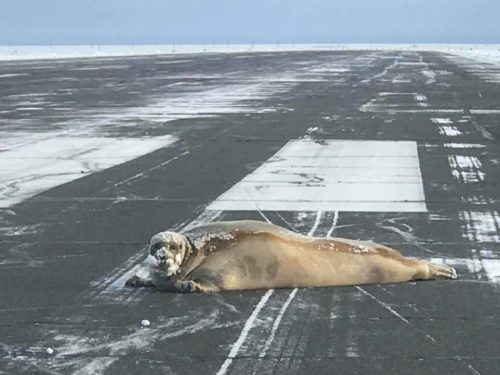
Courtesy Scott Babcock, Alaska Dept of Transportation Public-Facilities
The runway is about a quarter mile from the ocean, but airport staff believe the seal made a mile-long trek around the runway to get to its chosen spot.
“Animal control was called, and they loaded the seal onto a sled and pulled it off the runway with a snow machine,” said Meadow Bailey, spokesperson for the Alaska Department of Transportation & Public Facilities, “We refer to this as the day we warned of ‘low sealings’ at the airport.”
Have you spotted wildlife at your airport? Please share the story in the comments section below.